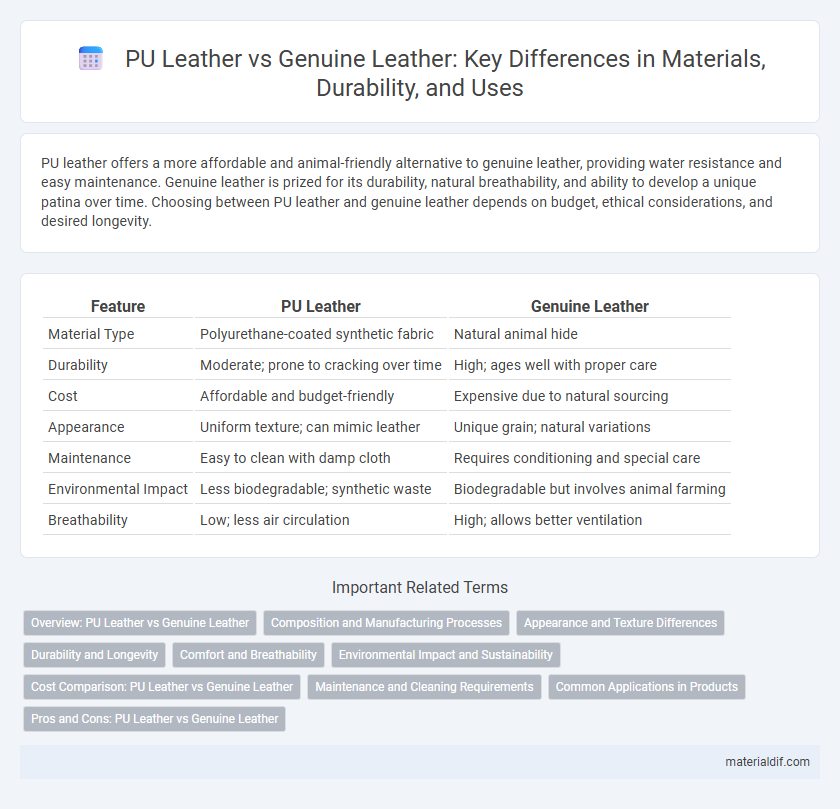PU leather offers a more affordable and animal-friendly alternative to genuine leather, providing water resistance and easy maintenance. Genuine leather is prized for its durability, natural breathability, and ability to develop a unique patina over time. Choosing between PU leather and genuine leather depends on budget, ethical considerations, and desired longevity.
Table of Comparison
| Feature | PU Leather | Genuine Leather |
|---|---|---|
| Material Type | Polyurethane-coated synthetic fabric | Natural animal hide |
| Durability | Moderate; prone to cracking over time | High; ages well with proper care |
| Cost | Affordable and budget-friendly | Expensive due to natural sourcing |
| Appearance | Uniform texture; can mimic leather | Unique grain; natural variations |
| Maintenance | Easy to clean with damp cloth | Requires conditioning and special care |
| Environmental Impact | Less biodegradable; synthetic waste | Biodegradable but involves animal farming |
| Breathability | Low; less air circulation | High; allows better ventilation |
Overview: PU Leather vs Genuine Leather
PU leather, also known as synthetic leather, is made by coating fabric with polyurethane, offering durability and water resistance at a lower cost. Genuine leather, derived from animal hides, provides natural breathability, unique texture, and long-lasting strength but requires more maintenance. The choice between PU leather and genuine leather depends on factors like budget, application, and desired aesthetic qualities.
Composition and Manufacturing Processes
PU leather consists of a fabric base coated with polyurethane, created through a synthetic process that combines polymer layers with textile backing, offering a uniform finish. Genuine leather is made from animal hides subjected to tanning and finishing procedures that preserve natural fibers and grain patterns while enhancing durability. The manufacturing of PU leather involves chemical treatments and heat curing, whereas genuine leather processing relies on traditional methods like vegetable or chrome tanning to maintain authenticity and breathability.
Appearance and Texture Differences
PU leather features a consistent, smooth surface with a uniform grain pattern, offering a synthetic shine that mimics genuine leather's natural luster. Genuine leather displays irregularities and natural markings, providing a rich, textured appearance that enhances with age and use. The texture of PU leather is typically softer and more flexible, while genuine leather feels firmer and develops a unique patina over time.
Durability and Longevity
PU leather offers moderate durability with resistance to scratches and stains, making it a budget-friendly alternative to genuine leather. Genuine leather excels in longevity, developing a unique patina over time and becoming more supple with regular use, which enhances its durability and value. While PU leather may crack and peel over prolonged use, genuine leather can last decades with proper care, making it a superior choice for long-term durability.
Comfort and Breathability
PU leather offers a more affordable and water-resistant alternative to genuine leather but tends to lack breathability, causing discomfort during extended wear. Genuine leather excels in comfort due to its natural fibers, which allow better airflow and moisture absorption, reducing sweat and skin irritation. For applications prioritizing breathability and long-term comfort, genuine leather remains the superior choice despite its higher cost.
Environmental Impact and Sustainability
PU leather has a lower environmental impact compared to genuine leather due to its synthetic production process, which avoids animal agriculture emissions and deforestation. However, PU leather relies on petrochemicals and non-biodegradable plastics, raising concerns about microplastic pollution and long-term waste. Genuine leather, despite being a byproduct of the meat industry, offers better biodegradability but contributes to greenhouse gas emissions and chemical pollution during tanning.
Cost Comparison: PU Leather vs Genuine Leather
PU leather typically costs 30-50% less than genuine leather, making it a budget-friendly option for furniture and fashion. Genuine leather's higher price reflects its durability, natural material quality, and aging characteristics. Consumers seeking affordability often choose PU leather, while those prioritizing longevity and premium feel invest in genuine leather.
Maintenance and Cleaning Requirements
PU leather requires minimal maintenance, needing only regular wiping with a damp cloth to remove dirt and spills, making it resistant to staining and easy to clean. Genuine leather demands more intensive care, including conditioning with specialized leather creams to prevent drying and cracking, alongside cautious cleaning to avoid damage from water or harsh chemicals. The durability and long-term appearance of genuine leather hinge on consistent upkeep, whereas PU leather offers a low-maintenance alternative suitable for frequent use.
Common Applications in Products
PU leather is widely used in affordable furniture upholstery, fashion accessories like handbags, and automotive interiors due to its durability and cost-effectiveness. Genuine leather remains the preferred choice for high-end products such as luxury shoes, premium wallets, and bespoke jackets, valued for its natural texture and longevity. Both materials cater to different market segments, with PU leather dominating mass-produced goods and genuine leather favored in artisan and luxury craftsmanship.
Pros and Cons: PU Leather vs Genuine Leather
PU leather offers affordability, water resistance, and ease of maintenance, making it a practical choice for budget-conscious consumers and high-traffic uses. Genuine leather provides superior durability, breathability, and a natural aging process that enhances its aesthetic appeal over time, but it requires more care and comes at a higher cost. While PU leather may peel and lacks the unique texture of genuine leather, genuine leather's susceptibility to stains and environmental damage can impact its longevity.
PU Leather vs Genuine Leather Infographic

 materialdif.com
materialdif.com